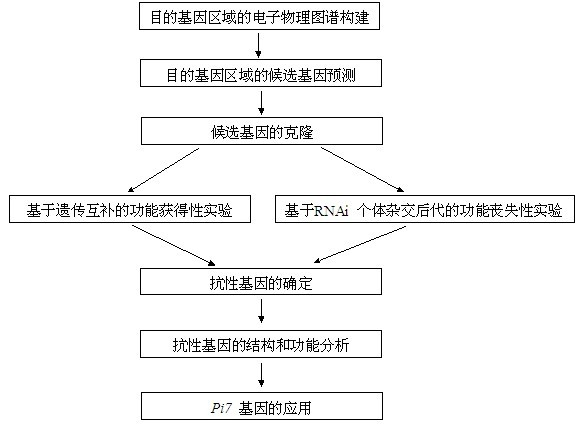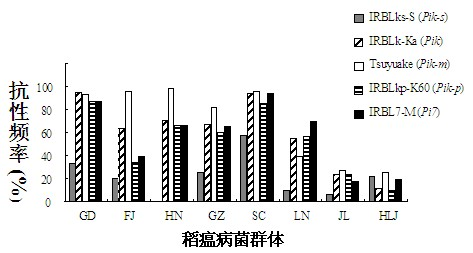Rice blast resistance gene Pi7 and application thereof
A technology of resistance gene and rice blast, applied in the field of genetic engineering, can solve the problems of lack of effective resistance gene, lack of sufficient understanding of resistance mechanism, and unsolved problems, and achieve the effect of shortening breeding time
- Summary
- Abstract
- Description
- Claims
- Application Information
AI Technical Summary
Problems solved by technology
Method used
Image
Examples
Embodiment 1
[0038] Example 1 Resistance Gene Pik-h resistance characteristics
[0039] for comparison and clarification Pi7 and Pik Locus 4 alleles ( Pik , Pik-p , Pik-s , Pik-m ) resistance spectrum, using strains from Guangdong (60 strains), Fujian (40 strains), Hunan (41 strains), Guizhou (60 strains), Sichuan (66 strains), Liaoning (108 strains), Jilin (60 strains) and A total of 498 strains collected in Heilongjiang (63 strains) were compared and analyzed for the resistance spectrum of the varieties held by the above five alleles (IRBL7-M, IRBLk-Ka, IRBLkp-K60, IRBLks-S and Tsuyuake, respectively). the result shows, Pi7 Higher resistance to the blast fungus populations in Guangdong, Hunan, Guizhou, Sichuan and Liaoning, indicating that the gene can be used in the above areas ( figure 2 ). Rice varieties RBL7-M, IRBLk-Ka, IRBLkp-K60 and IRBLks-S have been reported in the literature (Kobayashi et al. Development of new sets of international standard differential variet...
Embodiment 2
[0040] Example 2 Rice blast resistance gene Pi7 The cloning strategy and the construction of the electron physical map
[0041] Previous positioning studies have shown Pi7 gene localization with Pik Genomic regions where cluster genes are identical (Campbell et al. Development of co-dominant amplified polymorphic sequence markers in rice that flank the Magnaporthe grisea resistance gene Pi7 (t) in recombinant inbred line 29. Phytopathology, 2004, 94: 302-307; image 3 A); Anti-spectrum analysis in our laboratory shows Pi7 gene and Pik cluster of 3 alleles (except the less resistant Pik-s ) showed the same resistance response to most of the tested strains ( figure 2 ); previous research in our laboratory showed that, with Pi7 corresponding avirulent gene AvrPi7 also with Pik Avirulence gene corresponding to cluster resistance gene AvrPik / km / kp is equivalent. Based on the results of the above three aspects, according to the "gene-to-gene" theory of plant d...
Embodiment 3
[0042] Example 3 Rice blast resistance gene Pi7 Annotation and sequence analysis of candidate genes
[0043] to confirm Pi7 The applicant used the reference sequence of Nipponbare, through three gene prediction software RiceGAAS (http: / / ricegaas.dna.affrc.go.jp), Gramene (http: / / 143.48.220.116 / resources / ) and Softberry FGENESH (http: / / www.softberry.com) performed gene prediction and annotation analysis on the target gene region, and preliminarily determined that Pi7 The candidate resistance genes of 6 nucleotide binding sites and the candidate gene of NBS-LRR (nucleotide binding site - leucine-rich repeat, NBS-LRR) Pi71-NP , Pi72-NP , Pi73-NP , Pi74-NP , Pi75-NP ,and Pi76-NP ).
[0044] Based on the presence / absence (P / A) analysis of 6 candidate genes based on gene-specific markers, the results showed that, compared with Pik cluster of 3 alleles like the 4 candidate genes present in the Nipponbare reference sequence ( Pi71-NP , Pi72-NP , Pi73-NP , Pi7...
PUM
 Login to View More
Login to View More Abstract
Description
Claims
Application Information
 Login to View More
Login to View More - R&D
- Intellectual Property
- Life Sciences
- Materials
- Tech Scout
- Unparalleled Data Quality
- Higher Quality Content
- 60% Fewer Hallucinations
Browse by: Latest US Patents, China's latest patents, Technical Efficacy Thesaurus, Application Domain, Technology Topic, Popular Technical Reports.
© 2025 PatSnap. All rights reserved.Legal|Privacy policy|Modern Slavery Act Transparency Statement|Sitemap|About US| Contact US: help@patsnap.com



